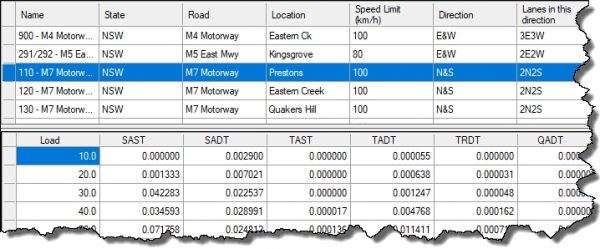Mechanistic Pavement Design – CIRCLY – Brisbane
One-day CIRCLY 7.0
Pavement Design Software Workshop
Brisbane, Thursday 8 March 2018

Overview
This is a hands-on workshop with PCs provided.
Only 16 places are available.
Pavement design in Australia has entered a new era with the release of the 2017 edition of the Austroads Guide to Pavement Technology: Part 2: Pavement Structural Design. The most extensive update to the Guide in more than a decade will significantly change the way in which designers develop next generation pavement engineering solutions. The new Guide was released in December.
This workshop will emphasize CIRCLY 7.0‘s implementation of the significant changes to the 2017 Austroads Guide.
The most significant change is how the details of the Traffic Load Distribution (TLD) are used as design inputs. The Traffic Load Distribution consists of the frequency distribution of Axle Group Loads.
Here’s an example of CIRCLY 7.0‘s Traffic Load Distribution screen:

The workshop will also introduce APSDS and HIPAVE, enhanced versions of CIRCLY which have been specifically developed for the design of airport and heavy industrial projects such as intermodal container terminal pavements.
Engineers Australia recognizes the CIRCLY Workshops for Continuing Professional Development (CPD) purposes.
Presenters
Leigh Wardle, Principal, Mincad Systems Pty Ltd
Leigh is the developer of CIRCLY, APSDS (Airport Pavement Structural Design System) and HIPAVE for Heavy Industrial Pavements such as intermodal container terminal pavement Design.
Ken McNabb, Principal, Mincad Systems Pty Ltd
Ken is experienced in a range of numerical modelling packages in the field of geomechanics and geotechnical engineering.
Overview of CIRCLY
The CIRCLY Pavement Design software is the core of the flexible pavement design methodology defined by the Austroads Pavement Design Guide.
CIRCLY is a proven design tool used over the past two decades in thousands of design applications worldwide.
CIRCLY 7.0 (2017) is a significant advancement in pavement design: a fully integrated system with superior design power and ease of use. CIRCLY 7.0 has many time-saving features such as an automatic thickness design capability that can save hours on a typical design job. A Parametric Analysis feature can loop through a range of thicknesses for one or two layers, while simultaneously designing the thickness of another layer. This feature will optimise up to three layers. Combining this with a Cost Analysis feature allows for fine-tuning of layer thicknesses to minimise construction and maintenance costs.
What will you achieve at the CIRCLY 7.0 workshop?
At the conclusion of this workshop you will:
- understand the theoretical basis of mechanistic pavement design methods
- appreciate the role and limitations of computer models in pavement design
- understand the sources of appropriate input data for pavement design, and
- have experience and knowledge on the use of CIRCLY for the design of flexible pavements as prescribed by the Austroads Pavement Design Guide
Suitable for:
This intensive one-day course focusing on flexible pavements is ideal for engineers and engineering technologists working for federal, state, or local authorities, consultants and contractors who have an awareness and understanding of the basic principles & practices of pavement design.
Click here for further information and Registration Form.
Related Events in the same week:
Flexible Pavement Design – Principles & Practices
Brisbane, Tuesday-Wednesday, 6-7 March 2018.
The Flexible Pavement Design – Principles & Practices Course is intended to inform on the basic principles & practices involved in pavement design, the course program will closely follow the content in the appropriate Chapters of the Austroads Guide to Pavement Technology – Part 2: Pavement Structural Design, which is used as the principal reference. The materials content will, however, cover more information than is in the current Guide, as the selection of materials is critical to producing a road/pavement design that will deliver both structural and functional performance.
